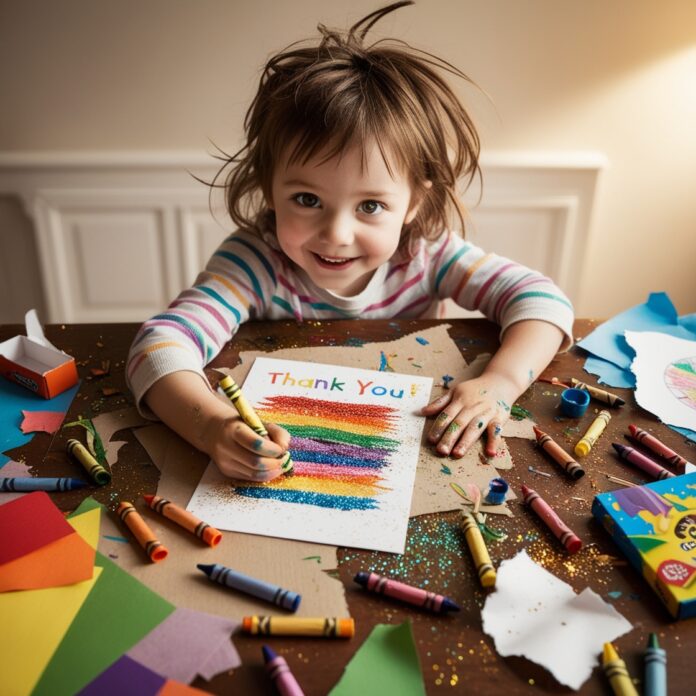Gratitude is more than saying “thank you”; it’s a way of thinking that will affect how children view the world and relate to others. Children who experience gratitude are more empathetic, resilient, and happy. But beyond words, teaching gratitude really requires consistent practices and appealing activities. This guide gives some handy tips and ideas on how to grow a sense of gratitude in children to make them appreciate whatever comes into their lives.
1. Why Gratitude Matters
Gratitude offers numerous benefits for children’s mental and emotional well-being:
- Better Relationships: Grateful children have a greater inclination to develop social contacts.
- Good Mental Health: Practicing gratitude reduces stress and increases positivity.
- Resilience: Gratitude helps kids navigate challenges with optimism and perspective.
Thus, parents who pay attention to gratitude will build qualities to support lifelong happiness and fulfillment in themselves.

2. Gratitude Modeling from a Parent
Children learn best by observing their parents. Being a role model of gratitude can significantly influence how they view the concept.
- Express Appreciation Regularly: Share what you’re thankful for during family meals or daily conversations.
- Acknowledge Others’ Kindness: Highlight moments when someone helps or contributes to the family’s well-being.
For example, saying, “I’m so grateful to Grandma for cooking such a delicious meal,” demonstrates the importance of recognizing others’ efforts.
3. Gratitude Activities for Kids
a) Gratitude Journals
Get your child to keep a gratitude journal in which they draw or write about the things they are grateful for.
- How to initiate: Just give them a simple notebook and ask them to write down three things they are grateful for each day.
- Benefit: It helps develop mindfulness in them and teaches them to look for the positive side of life.

b) Thank You Notes
Teach children to write thank-you notes from the heart, whether it be for gifts, acts of kindness, or support.
- Activity Idea: A thank-you card-making session with colorful paper and markers.
c) Gratitude Jar
Create a family gratitude jar in which each family member can contribute.
Steps:
- Decorate a jar with your child.
- Write down your gratitude moments on small scraps of paper.
- Review them together once a month.
4. Daily Practices to Build Gratitude
a) Practice Gratitude at Mealtime
Turn meals into a time to express thankfulness.
- For instance, go around the table and ask each person to share one thing for which they are thankful today.

b) Reflect on Challenges
Teach kids to identify the bright side of life even during difficult times.
- Example: After a hard day, discuss what they learned or appreciated about their experience.
c) Use Affirmations
Teach kids positive affirmations that incorporate gratitude.
- For example, “I appreciate having my family and friends around.”
5. Teaching Gratitude Through Stories
Books and stories are powerful tools for teaching values like gratitude.
Recommended Books:
- The Thank You Book by Mo Willems.
- John Bucchino’s Grateful: A Song of Giving Thanks.
- Have You Filled a Bucket Today? by Carol McCloud.
Reading together allows children to visualize and understand the importance of being thankful.

6. Gratitude in Social Interactions
a) Volunteer Together
Community service helps kids appreciate what they have and develop empathy for others.
- Examples: Donate toys to a shelter or volunteer at a food bank.

b) Nurture Gratitude in Friendships
Teach your child to be thankful to friends.
- Activity: Have them prepare little “thank you” gifts for friends or teachers.
c) Appreciate Acts of Kindness
Acknowledge acts of kindness your child receives and encourage them to give back.
7. Challenges in Teaching Gratitude
a) Handling Materialism
With the world bombarding kids with advertisements and peers who have more, kids may become focused on what they don’t have rather than what they do.
- Solution: Restrict screen time and focus on experiences over stuff.
b) Building Patience
Gratitude is an attitude that takes time. Be consistent.
- Tip: Reinforce small acts of gratitude with praise.
c) Dealing with Entitlement
When entitlement becomes an issue, steer their focus toward the things they shouldn’t take for granted: a roof over their head or good health.
8. Long-Term Benefits of Gratitude
Cultivating gratitude will help build a foundation toward a child’s optimistic approach to life. Grateful children are likely to be
Appreciative adults recognize the contribution of others. Optimistic individuals focus on possibilities rather than constraints through gratitude. Resilient people can enjoy things despite adverse situations.
One of the most impactful lessons a parent can teach a child is gratitude. With regular practices, fun activities, and an emphasis on creating a positive atmosphere, gratitude will become second nature for any child. By modeling thankfulness and providing tools to recognize life’s blessings, parents can help their children develop a habit that will serve them well into adulthood.



